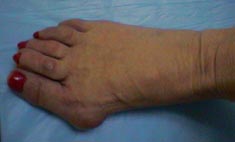

- See:
- adolescent bunion
- bunionette
- Discussion:
- pathophysiology
- blood supply of MCP joint
- windlass mechanism
- diff dx:
- gout
- hallux rigidus (cheilectomy);
- references:
- Anatomic variations in the first ray: Part I. Anatomic aspects related to bunion surgery.
- Muscle in hallux valgus.
- Kinematics of the first metatarsophalangeal joint.
- Hallux valgus--etiology, anatomy, treatment and surgical considerations.
- Physical Exam:
- vascular status: dorsalis pedis and posterior tibial artery;
- ankle equinus deformity (loss of ankle dorsiflexion may accentuate forefoot pain);
- determine the correctability of the deformity:
- degree to which standing accentuates the deformity;
- passive correctability of the hallux valgus and determine the ROM of the MTP joint in both the corrected and uncorrected positions;
- toe stiffness: note whether the toe is stiff once placed in the corrected position?
- a mildly symptomatic hallux valgus is preferable to a stiff corrected MTP joint;
- note that a technically correct surgical procedure may leave toe stiff once placed in corrected position (due to soft tissue contractures);
- the result may be pain w/ toe off during gait;
- amount of 1st toe pronation (associated w/ severity);
- first MT-cuneiform joint is evaluated for hypermobility and tenderness (involves pushing the MT head into dorsiflexion & plantar flexion);
- ref: Instability of the First Metatarsal-Cuneiform Joint: Diagnosis and Discussion of an Independent Pain Generator in the Foot
- tenderness over medial aspect of MTP joint;
- occurs from irritation of the dorsal cutaneous nerve;
- may occur from hypetrophic bursa;
- generalized ligamentous laxity: note that standard reconstructive techniques may fail in this patients;
- Radiographs:
- is the hallux valgus congruent or incongruent?
- congruent joint are less likely to progress than non congruent joints;
- Non-Operative Treatment:
- pts w/o DJD of MTP joint may benefit from lace up shoes w/ a wide toe box;
- pts w/ equinus contracture may benefit from stretching, which may unload the forefoot and relieve pain;
- pts w/ DJD of MTP (hallux rigidus) may benefit from a stiff soled shoe;
- Operative Treatment:
- surgical approach to MTP joint:
- pertinent blood supply;
- make a curved incision 5 cm long on the medial aspect of the joint;
- begin incision proximal to IP joint, curve it over the dorsum of MP joint just medial to EHL tendon;
- end incision on medial aspect of first metatarsal 2.5 cm proximal to joint;
- dorsally take care to identify:
- medial branch of first dorsal metatarsal artery
- medial branch of 1st dorsal cutaneous nerve (branch of superficial peroneal nerve) which supplies medial side of great toe;
- dissect the fascia from the dorsum down to the bursa over the medial aspect of the metatarsal head;
- ref: Dorsomedial cutaneous nerve syndrome: Treatment with nerve transection and burial into bone.
- surgical options:
- akin procedure
- ref: Late results after correction of hallux valgus deformity by basilar phalangeal osteotomy.
- arthrodesis
- ref: Arthrodesis of the first metatarsophalangeal joint in rheumatoid arthritis. Biodegradable rods and Kirschner-wires in 39 cases.
- chevron osteotomy
- hallux rigidus
- keller procedure
- lapidus procedure
- ludloff osteotomy
- mau osteotomy
- mcbride procedure:
- ref: McBride's operation for hallux valgus. A 2-11-year follow-up of 46 cases.
- mitchell bunion procedure
- proximal MT osteotomy
- silver procedure
- soft tissue release and capsular repair
- surgical treatment based on radiographic anatomy:
- mild deformity:
- for mild to moderate deformity (IM angle from 9 to 13 deg)
- consider soft tissue procedure (modified Mcbride procedure) or distal osteotomy (chevron or Mitchell type)
- moderate deformity:
- moderate to severe deformities (13 to 20 deg) is best treated w/ soft tissue release & proximal MT osteotomy;
- prominent medial eminence: consider a concomitant silver procedure;
- severe deformity:
- w/ hallux valgus deformity > 30 deg w/ IM angle > 12 deg consider distal soft tissue release w/ proximal osteotomy;
- MTP joint arthrodesis is another option;
- lapidus procedure: indicated for severe deformity + hypermobile 1st ray;
- wound closure:
- following the hallux valgus reconstructive procedure, the sesamoids may still lie in a subluxed positioned;
- posterior to anterior closure:
- partial reduction of the sesamoids may be achieved w/ closure of the joint capsule;
- excise the inferior portion of the joint capsule, place the toe in a slightly over-corrected position, and then oppose the inferior joint
capsule to the superior joint capsule w/ non absorbable sutures;
- goal of this is to de-rotate sesamoids out of their laterally subluxed position, to a more anatomic position under the metatarsal;
- distal to proximal closure
- figure of 8 closure spaning proximal and distal MTP joint will have the effect of tightening the medial capsule;
- Post-operative Pain Management:
- references:
- Bupivacaine liposome injectable suspension: a new approach to postsurgical pain.
- Impact of local liposome bupivacaine for postsurgical analgesia on wound healing: a review of data from 10 clinical studies.
- Pharmacokinetic profile of liposome bupivacaine injection following a single administration at the surgical site.
- Other Surgical Considerations:
- hammer toe correction
- ankle equinus contracture
- Complications:
- hallux varus:
- excessive resection of medial metatarsal head;
- excision of medial sesamoid;
- excessive capsular plication;
- immobilization of the toe in excessive varus during the post op period;
- ref: The operative treatment of acquired hallux varus.
Wilson's osteotomy for the treatment of hallux valgus.
The modified Wilson osteotomy for hallux valgus.
Distal metatarsal osteotomy for hallux valgus in the middle-aged patient.
The risks and benefits of distal first metatarsal osteotomies.
Monarticular nontraumatic synovitis of the metatarsophalangeal joint: a new diagnosis?
The treatment of hallux valgus with overriding second toe.
Extensor hallucis longus transfer for hallux valgus deformity.
Shortening of the first metatarsal as a complication of metatarsal osteotomies.
A prospective study of forefoot arthroplasty.
Survivorship analysis of implant arthroplasty for the first metatarsophalangeal joint.

